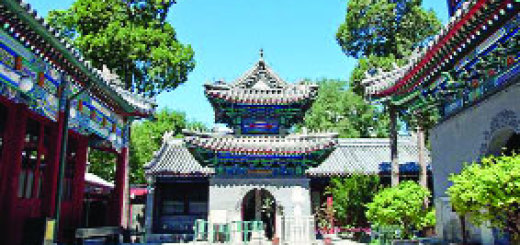A Taste for Haste
On a recent evening at Ttobagi Driver’s Restaurant in Seoul’s Gwanak District, I surreptitiously started a timer upon placing my order. The waitress strolled off in a leisurely fashion, returning with kimchi and other side dishes just two minutes and 20 seconds later. One and half minutes after that, a clay bowl of ppyeodagwi haejangguk (pork-spine ‘hangover’ soup) was set on the table, steaming furiously.
It’s remarkable enough that such service exists in a country where tipping is not practiced. More remarkable still, though, is that Ttobagi, an unpretentious spot frequented by taxi drivers, is no faster than the next place.
Routine speediness runs through South Korean society and is especially prevalent in the capital. There is even a term for it: ppalli-ppalli culture. Translating to ‘fast’ or ‘hurry’, ppalli is pronounced with a tensed first consonant, as if snapping the vocal apparatus like a rubber band.
The ppalli-ppalli tendency can be seen in South Korea’s world-leading internet speeds, intensive language classes promising near-immediate results and popular speed-dating events. And just as time-conscious are the glitzy wedding halls that host a succession of hour-long ceremonies all weekend.
Ppalli-ppalli is also the watchword of the thousands of food delivery motorcyclists who bend the rules of traffic – and physics, too, it appears – to deliver their orders post-haste. To compete, McDonald’s, the global leader in fast food, began assembling its own fleets of delivery scooters in South Korea in 2007.
Yet not long ago, Korea was a great deal slower due to its rural complexion. In 1960, a whopping 72% of the population lived in the countryside. So how did the people go from transplanting rice to downloading torrents in just a few decades?
Naturalised Korean citizen Gary Rector, who arrived in Seoul as a Peace Corps volunteer in 1967, reflects, “I remember being surprised because, before I came here, I had this stereotypical idea that they’re going to be zenned-out, meditating and taking life slowly. And yet I found that people were often rushing around more than Americans would. The older people were slower, but people my age – and I was 24 years old – were very busy rushing around trying to improve their lifestyle.”
Rector came during a time of intense change. In the early ’60s, South Korea embarked upon a series of five-year economic plans put forward by then-president Park Chung-hee. These military-style campaigns brought about the Miracle on the Han River (the transformation from a war-ruined country to an economic powerhouse), and created Korea Inc, represented by such corporate behemoths as Samsung, Hyundai and LG.
The fruits of ppalli-ppalli are on proud display at the National Museum of Korean Contemporary History in central Seoul. Aptly, South Korea’s spirit of urgent advancement can be said to have issued from this very building. Long before becoming a museum space, it housed both the Supreme Council for National Reconstruction and the Economic Planning Board.
In the exhibition hall covering 1961-1987, South Korea’s period of explosive growth, I watched a young couple peer at the country’s first piece of consumer electronics, the A-501 Radio, which was in fact made in 1959. Nearby, a father showed his son the boxy, cyan-blue Hyundai Pony, which first rolled off an assembly line in 1975.
Mind-bogglingly, the country’s exports during this period grew by 30% to 40% per year. The boldness of the economic planners and the zeal of the workforce allowed the country to leapfrog from exporting raw silk and iron ore to making factory items like wigs and textiles. Then, learning on the fly, the nation graduated to consumer electronics, oil tankers and semiconductors.
Anthropologist Kim Choong-soon attributes much of South Korea’s success as an exporter to the focus on speed. “The practice of ppalli-ppalli is not merely part of daily life for Koreans; expeditiousness is embedded deeply in their minds as a basic value,” he writes in Way Back into Korea. “Thanks to this culture of hurry, [South] Korea was able to achieve tremendous economic progress and industrialisation in a very short period of time”.
The defining symbol of ppalli-ppalli achievement remains the Gyeongbu Expressway, which runs 428km south-east from Seoul to the second city of Busan. Originally slated to take three and half years, the highway was completed just two years and five months after the 1968 ground-breaking ceremony. All told, about nine million man-days of labour were poured into the project.
By no means, though, has the speed of construction in South Korea tapered off since then. An entire cutting-edge city, Songdo International Business District, was erected on reclaimed land south-west of Seoul starting in 2004, with the first phase – comprising a sprawling park, convention centre, Sheraton hotel and set of apartment towers – opening just five years later. Even more ambitious – and faster – was the administrative centre of Sejong City, about 120km south of Seoul, which was built from scratch starting in 2010 and inaugurated in 2012.
Though South Korea gets more recognition for its fleetness, North Korea seems to have the speed bug too. Kim Il-sung, the founding leader of North Korea, encouraged workers to aspire to ‘chollima speed’, referring to a mythical horse that flies around 400km per day.
But the Supreme Leader’s grandson, Kim Jong-un, shifted up a few gears with the slogan ‘mallima speed’ – a 10-time increase. His sloganeering has borne some results, with showpiece apartment towers on Pyongyang’s Ryomong Street opening in 2017 after only a year of construction.
This begs the question of whether the roots of ppalli-ppalli culture go deeper than the modern era. Kim wagers that they do. “Building and construction in the historic past were also completed ahead of schedule,” he writes, quoting the construction of Hwaseong in Suwon as an example. This grand fortress, recognised as a Unesco World Heritage site, was finished seven years early, in 1796, and remains in excellent condition.
Similarly, one wonders if the exquisite celadon of the Goryeo dynasty (918-1392) was created on the potter’s wheel with the same efficiency that characterises Korean productions today. Manual dexterity and artistic mastery were certainly prized in the 16th Century, when the calligrapher Han Seok-bong painted Chinese characters in a range of scripts, including a vigorous cursive. Painting lines of poetry without lifting brush from paper requires absolute control – and speed.
Though few South Koreans can wield a brush these days, many have developed extremely agile thumbs. The LG Mobile World Cup, a text-messaging competition, was won by the Korean team when it was held in New York in 2010. And it may be no coincidence that Korean Olympians have excelled at rapid-fire sports like archery and shooting. They have dominated most of all, though, at short-track speed skating, amassing a total of 48 Olympic medals to date.
Yet outside commentators sometimes overly rely on the idea of ppalli-ppalli when trying to explain Korea, notes Koo Se-woong, publisher of Korea Exposé, an independent media outlet specialising in the Korean Peninsula. “It’s almost like a caricature of Korean culture,” Koo said. “I understand that there is an emphasis on speed here, but it’s strange to see how that is distilled into this particular expression which is not even employed by Koreans themselves with any kind of frequency.”
And while many Koreans have fully embraced the convenience of instant noodles and same-day parcel deliveries, others have rejected the hustle and bustle of city life. Numerous celebrities, for instance, have moved to the southern island of Jeju, which is much slower paced. These include pop diva Lee Hyori and her husband Lee Sang-soon, who showcased their bucolic lifestyle on the hit reality television show Hyori’s Bed and Breakfast. But it is hard to predict how long the back-to-the-soil moment will last. Korean social trends, too, change with the blink of an eye.
The feature is written by
Matt C. Crawford
















Recent Comments